automatic transmission SAAB 9-5 2003 Owners Manual
[x] Cancel search | Manufacturer: SAAB, Model Year: 2003, Model line: 9-5, Model: SAAB 9-5 2003Pages: 288, PDF Size: 16.78 MB
Page 5 of 288
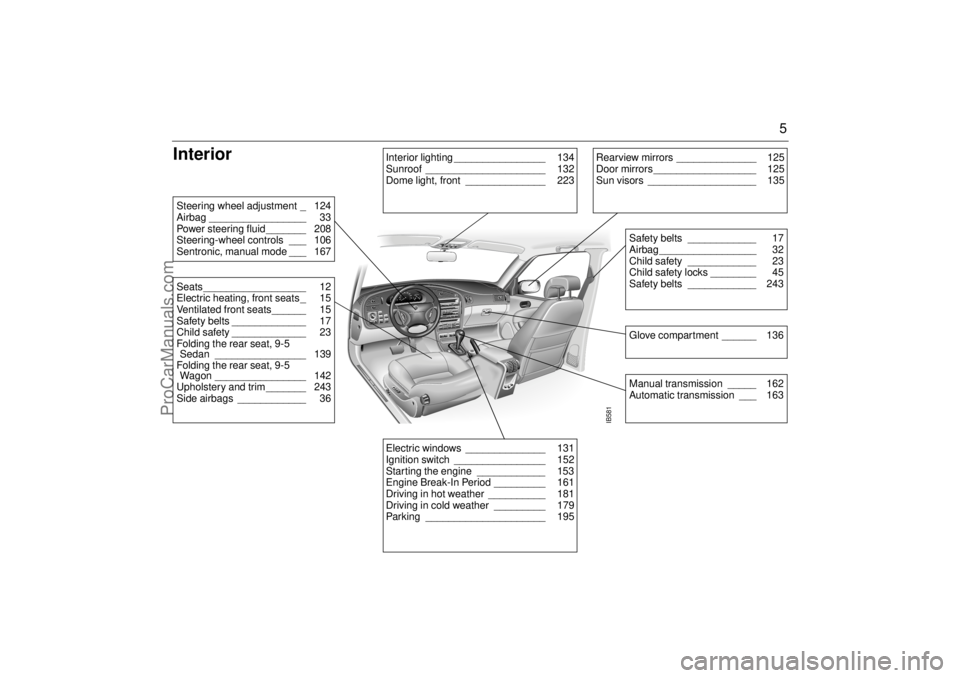
5
Interior
IB581
Rearview mirrors ______________ 125
Door mirrors __________________ 125
Sun visors ___________________ 135
Safety belts ____________ 17
Airbag _________________ 32
Child safety ____________ 23
Child safety locks ________ 45
Safety belts ____________ 243Glove compartment ______ 136Manual transmission _____ 162
Automatic transmission ___ 163
Electric windows ______________ 131
Ignition switch ________________ 152
Starting the engine ____________ 153
Engine Break-In Period _________ 161
Driving in hot weather __________ 181
Driving in cold weather _________ 179
Parking _____________________ 195
Steering wheel adjustment _ 124
Airbag _________________ 33
Power steering fluid _______ 208
Steering-wheel controls ___ 106
Sentronic, manual mode ___ 167Seats __________________ 12
Electric heating, front seats _ 15
Ventilated front seats______ 15
Safety belts _____________ 17
Child safety _____________ 23
Folding the rear seat, 9-5
Sedan ________________ 139
Folding the rear seat, 9-5
Wagon ________________ 142
Upholstery and trim _______ 243
Side airbags ____________ 36
Interior lighting ________________ 134
Sunroof _____________________ 132
Dome light, front ______________ 223
ProCarManuals.com
Page 6 of 288

6Engine compartment,
4-cyl engine
IB1737
Engine ______________________ 202
Checking the oil level ___________ 203
Oil changing__________________ 204
Engine oil, specification _________ 261
Braking______________________ 172
ABS brakes __________________ 173
Brake and clutch fluid ___________ 207
Brake system _________________ 265
Brake pads ___________________ 265
Fuses _________________ 226
Changing a fuse _________ 228
Relays ________________ 229
Table of fuses ___________ 226Temperature gauge ______ 63
Driving in hot weather_____ 181
Driving in cold weather ____ 179
Coolant________________ 206
Coolant capacity_________ 260
Power steering fluid _______ 208
Steering, technical data ___ 265
Wipers and washers ______ 75
Washers _______________ 213
Washer jets ____________ 213
Jump starting _________________ 191
Battery ______________________ 209
Charging/replacing the battery____ 210
Manual transmission ___________ 162
Automatic transmission _________ 163
Automatic transmission,
technical data ________________ 264
Manual gearbox, technical data ___ 264
Important considerations for driving 155
Turbo unit ___________________ 199
Engine, technical data __________ 260Ignition switch ___________ 152
Drive belts ______________ 211
Spark plugs _____________ 263
Catalytic converter _______ 156Warning labels __________ 8
V.I.N. number ___________ 269
Engine number __________ 269
Gearbox number _________ 269
Color code______________ 269
ProCarManuals.com
Page 7 of 288

7
Engine compartment,
3.0t V6
IB1738
Warning labels __________ 8
V.I.N. number ___________ 269
Engine number __________ 269
Gearbox number ________ 269
Color code _____________ 269Ignition switch ___________ 152
Drive belts ______________ 211
Spark plugs _____________ 263
Catalytic converter _______ 156Important considerations for driving 155
Turbo unit ___________________ 199
Engine, technical data __________ 260
Automatic transmission _________ 163
Automatic transmission,
technical data ________________ 264
Braking______________________ 172
ABS brakes __________________ 173
Brake and clutch fluid ___________ 207
Brake system _________________ 265
Brake pads ___________________ 265Jump starting _________________ 191
Battery ______________________ 209
Charging/replacing the battery____ 210
Fuses _________________ 226
Changing a fuse _________ 228
Relays ________________ 229
Table of fuses ___________ 226Temperature gauge ______ 63
Driving in hot weather_____ 181
Driving in cold weather ____ 179
Coolant________________ 206
Coolant capacity_________ 260
Power steering fluid _______ 208
Steering, technical data ___ 265
Wipers and washers ______ 75
Washers _______________ 213
Washer jets ____________ 213
Engine ______________________ 202
Checking the oil level ___________ 203
Oil changing__________________ 204
Engine oil, specification _________ 261
ProCarManuals.com
Page 60 of 288

60 Instruments and controls
Indicator, cruise control
This light shows when the cruise-control
system is active (see page 171).
Indicator, high beam
This light shows when the headlights are on
high beam (see page 71).
Indicator, rear fog light
This light shows when the rear fog light is on
(see page 72).
The rear fog light is switched off automat-
ically when the engine is switched off. When
the fog light is next needed, it will have to be
switched on manually again.
The rear fog light consists of one light so it
should not be mistaken for brake lights.
Bi-Xenon headlight fault
indicator
(certain variants only)
This light indicates that there is a fault in the
Bi-Xenon headlight system, which consists
of xenon headlights and an automatic level-
ling system.
If a fault arises in the Bi-Xenon headlight
system, the headlights will be angled down
to avoid dazzling drivers in oncoming traffic.
Adjust your speed accordingly as visibility
will be reduced.
Indicator, open door
If a door has not been closed properly, the
pictogram will indicate the door concerned
(or tailgate).
Indicator, SPORT-mode
automatic transmission
This light will come on in cars with automatic
transmission when the S (SPORT) button
on the selector lever has been pressed
(position N or D) see page 170.
In this mode, the gear changes occur later,
at higher engine revs, giving the engine and
transmission a sportier feel.
To cancel the SPORT mode, press the S
button on the selector lever again. The
mode is also deselected automatically
w h e n t h e s e l e c t o r l e v e r i s m o v e d t o P , R , M
or L.
Indicator, WINTER-mode
automatic transmission
This light shows when the WINTER mode
has been selected in cars with automatic
transmission (see page 170).
In the WINTER mode, the car pulls away in
3rd gear, to help prevent wheelspin on an
icy road.
To cancel the WINTER mode, press the W
button.
NOTICEIf the Bi-Xenon headlight fault indicator
lights up, have your car checked as soon
as possible at an authorized Saab dealer.
If you do not rectify the problem, nighttime
visibility will be poor since the range of the
headlights is reduced.
ProCarManuals.com
Page 61 of 288
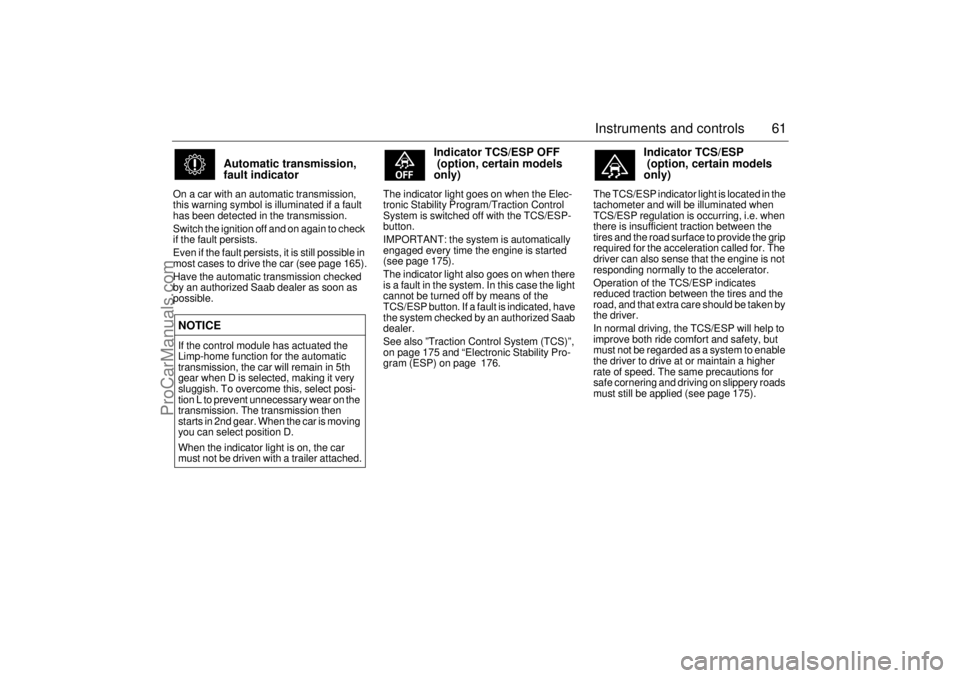
61 Instruments and controls
Automatic transmission,
fault indicator
On a car with an automatic transmission,
this warning symbol is illuminated if a fault
has been detected in the transmission.
Switch the ignition off and on again to check
if the fault persists.
Even if the fault persists, it is still possible in
most cases to drive the car (see page 165).
Have the automatic transmission checked
by an authorized Saab dealer as soon as
possible.
Indicator TCS/ESP OFF
(option, certain models
only)
The indicator light goes on when the Elec-
tronic Stability Program/Traction Control
System is switched off with the TCS/ESP-
button.
IMPORTANT: the system is automatically
engaged every time the engine is started
(see page 175).
The indicator light also goes on when there
is a fault in the system. In this case the light
cannot be turned off by means of the
TCS/ESP button. If a fault is indicated, have
the system checked by an authorized Saab
dealer.
See also ”Traction Control System (TCS)”,
on page 175 and “Electronic Stability Pro-
gram (ESP) on page 176.
Indicator TCS/ESP
(option, certain models
only)
The TCS/ESP indicator light is located in the
tachometer and will be illuminated when
TCS/ESP regulation is occurring, i.e. when
there is insufficient traction between the
tires and the road surface to provide the grip
required for the acceleration called for. The
driver can also sense that the engine is not
responding normally to the accelerator.
Operation of the TCS/ESP indicates
reduced traction between the tires and the
road, and that extra care should be taken by
the driver.
In normal driving, the TCS/ESP will help to
improve both ride comfort and safety, but
must not be regarded as a system to enable
the driver to drive at or maintain a higher
rate of speed. The same precautions for
safe cornering and driving on slippery roads
must still be applied (see page 175).
NOTICEIf the control module has actuated the
Limp-home function for the automatic
transmission, the car will remain in 5th
gear when D is selected, making it very
sluggish. To overcome this, select posi-
tion L to prevent unnecessary wear on the
transmission. The transmission then
starts in 2nd gear. When the car is moving
you can select position D.
When the indicator light is on, the car
must not be driven with a trailer attached.
ProCarManuals.com
Page 62 of 288
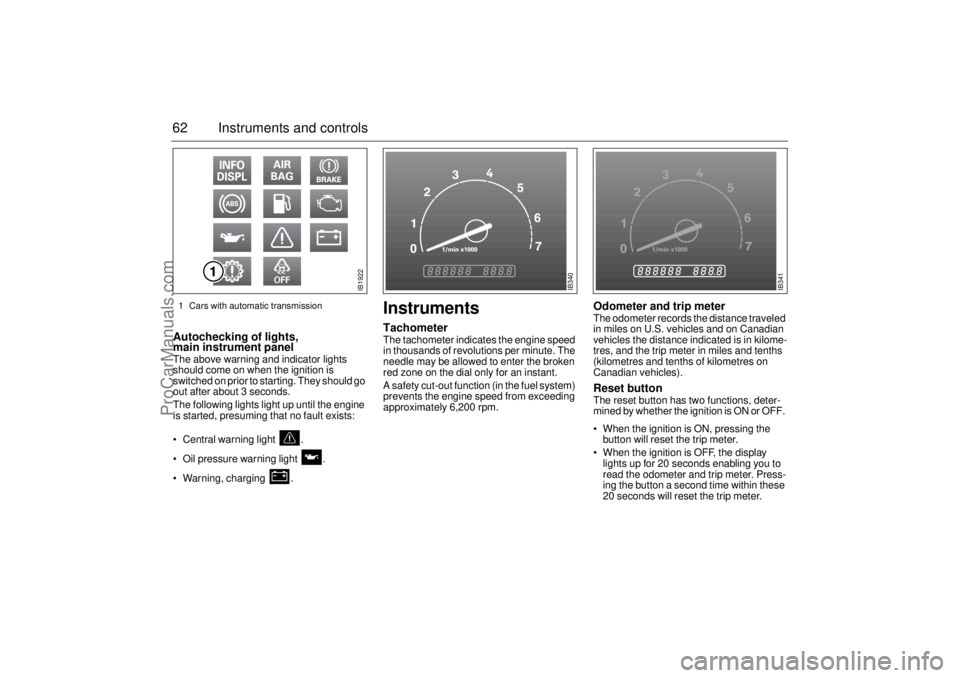
62 Instruments and controlsAutochecking of lights,
main instrument panel The above warning and indicator lights
should come on when the ignition is
switched on prior to starting. They should go
out after about 3 seconds.
The following lights light up until the engine
is started, presuming that no fault exists:
Central warning light .
Oil pressure warning light .
Warning, charging .
InstrumentsTachometerThe tachometer indicates the engine speed
in thousands of revolutions per minute. The
needle may be allowed to enter the broken
red zone on the dial only for an instant.
A safety cut-out function (in the fuel system)
prevents the engine speed from exceeding
approximately 6,200 rpm.
Odometer and trip meter The odometer records the distance traveled
in miles on U.S. vehicles and on Canadian
vehicles the distance indicated is in kilome-
tres, and the trip meter in miles and tenths
(kilometres and tenths of kilometres on
Canadian vehicles). Reset button The reset button has two functions, deter-
mined by whether the ignition is ON or OFF.
When the ignition is ON, pressing the
button will reset the trip meter.
When the ignition is OFF, the display
lights up for 20 seconds enabling you to
read the odometer and trip meter. Press-
ing the button a second time within these
20 seconds will reset the trip meter.
IB1922
IB340
IB341
1 Cars with automatic transmission
ProCarManuals.com
Page 65 of 288

65 Instruments and controls
Selector lever indication
(Automatic transmission) The position of the selector lever is indi-
cated on the main instrument panel. If
manual mode is selected, the current gear
is also displayed.
Saab Information
Display (SID) The Saab Information Display (SID) shows
CHECK messages and incorporates eight
trip-computer functions.
The SID is also used by the Audio System.
Trip computerSelecting the function
Use the button to scroll through the
following functions: Use the button to scroll through the
following functions:
WARNING
It is strongly recommended that the SID
settings be changed only when the car is
stationary. The driver’s attention can
otherwise easily be distracted from the
road.
DIST Distance to destination / Trip
meter.
ARRIV Estimated time of arrival.
ALARM Alarm function.
SPD W Speed warning (chime).
TEMP Outdoor temperature and Date.
D.T.E. Estimated range (distance to
empty fuel tank).
FUEL∅ Average fuel consumption
since function last reset.
SPD∅ Average speed since function
last reset.
NIGHT PANEL
CLEAR
SET
IB346
ProCarManuals.com
Page 70 of 288
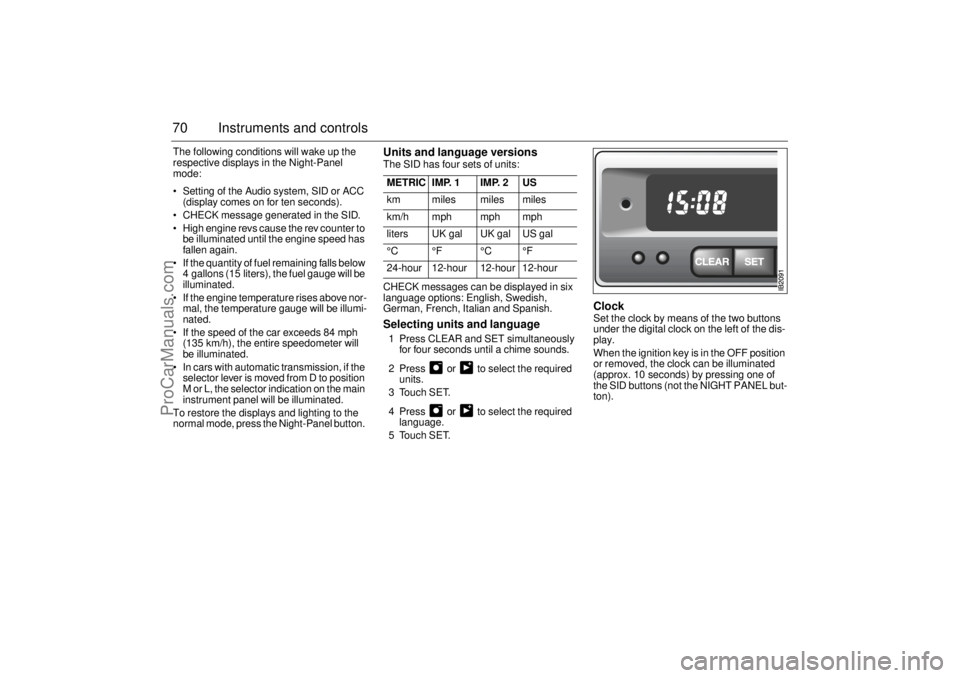
70 Instruments and controlsThe following conditions will wake up the
respective displays in the Night-Panel
mode:
Setting of the Audio system, SID or ACC
(display comes on for ten seconds).
CHECK message generated in the SID.
High engine revs cause the rev counter to
be illuminated until the engine speed has
fallen again.
If the quantity of fuel remaining falls below
4 gallons (15 liters), the fuel gauge will be
illuminated.
If the engine temperature rises above nor-
mal, the temperature gauge will be illumi-
nated.
If the speed of the car exceeds 84 mph
(135 km/h), the entire speedometer will
be illuminated.
In cars with automatic transmission, if the
selector lever is moved from D to position
M or L, the selector indication on the main
instrument panel will be illuminated.
To restore the displays and lighting to the
normal mode, press the Night-Panel button.
Units and language versionsThe SID has four sets of units:
CHECK messages can be displayed in six
language options: English, Swedish,
German, French, Italian and Spanish. Selecting units and language 1 Press CLEAR and SET simultaneously
for four seconds until a chime sounds.
2 Press or to select the required
units.
3 Touch SET.
4 Press or to select the required
language.
5 Touch SET.
Clock Set the clock by means of the two buttons
under the digital clock on the left of the dis-
play.
When the ignition key is in the OFF position
or removed, the clock can be illuminated
(approx. 10 seconds) by pressing one of
the SID buttons (not the NIGHT PANEL but-
ton). METRIC IMP. 1 IMP. 2 US
km miles miles miles
km/h mph mph mph
liters UK gal UK gal US gal
°C °F °C °F
24-hour 12-hour 12-hour 12-hour
ProCarManuals.com
Page 152 of 288
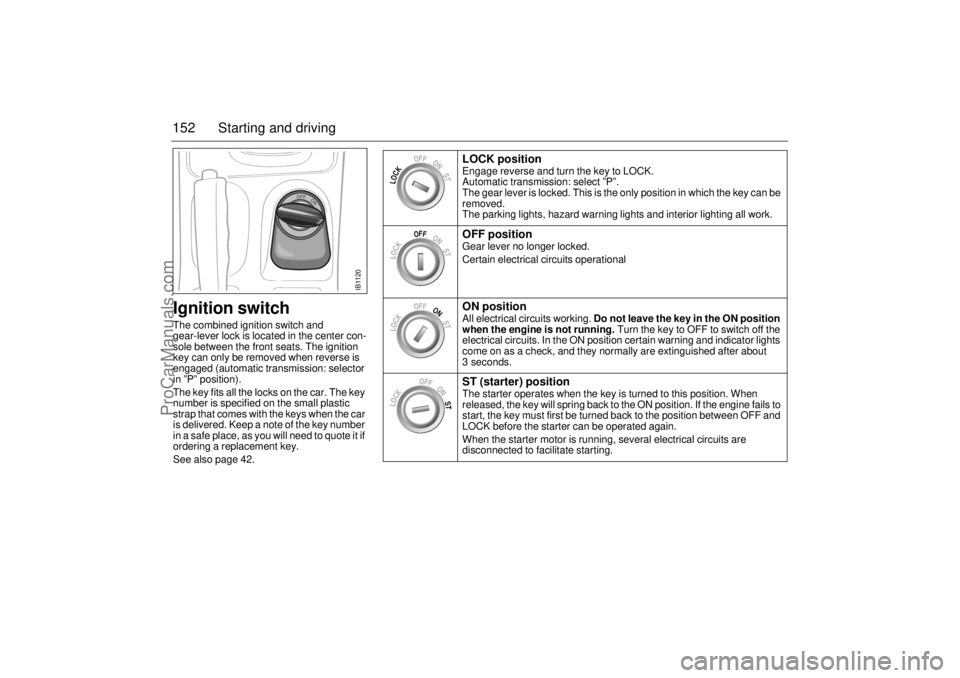
152 Starting and drivingIgnition switchThe combined ignition switch and
gear-lever lock is located in the center con-
sole between the front seats. The ignition
key can only be removed when reverse is
engaged (automatic transmission: selector
in ”P” position).
The key fits all the locks on the car. The key
number is specified on the small plastic
strap that comes with the keys when the car
is delivered. Keep a note of the key number
in a safe place, as you will need to quote it if
ordering a replacement key.
See also page 42.
LOCK position Engage reverse and turn the key to LOCK.
Automatic transmission: select ”P”.
The gear lever is locked. This is the only position in which the key can be
removed.
The parking lights, hazard warning lights and interior lighting all work. OFF position Gear lever no longer locked.
Certain electrical circuits operationalON position All electrical circuits working. Do not leave the key in the ON position
when the engine is not running. Turn the key to OFF to switch off the
electrical circuits. In the ON position certain warning and indicator lights
come on as a check, and they normally are extinguished after about
3 seconds.ST (starter) position The starter operates when the key is turned to this position. When
released, the key will spring back to the ON position. If the engine fails to
start, the key must first be turned back to the position between OFF and
LOCK before the starter can be operated again.
When the starter motor is running, several electrical circuits are
disconnected to facilitate starting.
LOCK
OFFONST
LOCK
OFFONST
LOCK
OFFONST
LOCK
OFFONST
IB1120
ProCarManuals.com
Page 153 of 288
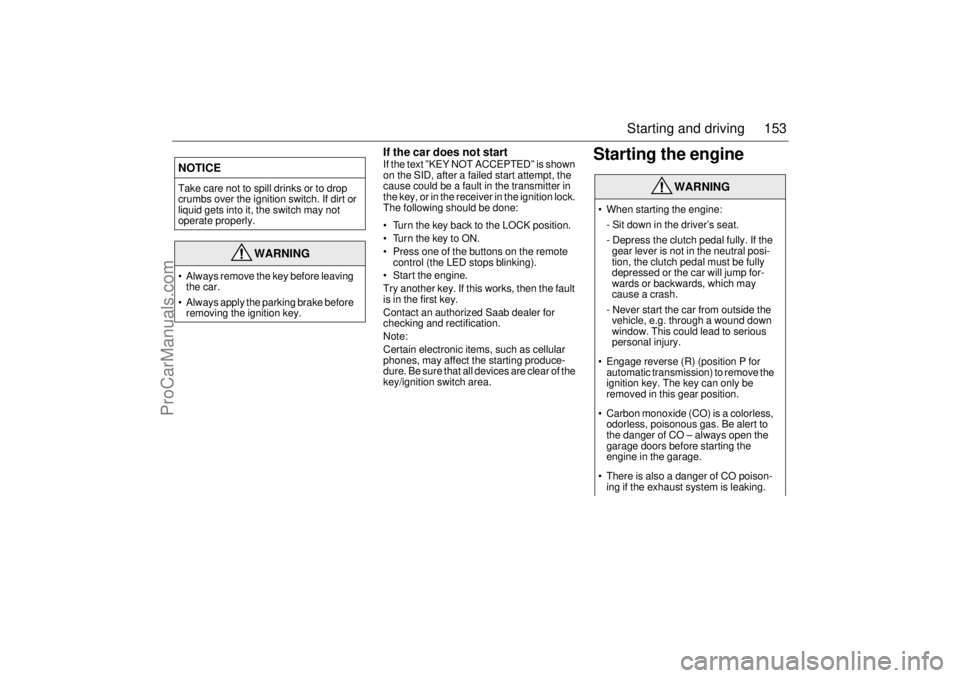
153 Starting and driving
If the car does not startIf the text ”KEY NOT ACCEPTED” is shown
on the SID, after a failed start attempt, the
cause could be a fault in the transmitter in
the key, or in the receiver in the ignition lock.
The following should be done:
Turn the key back to the LOCK position.
Turn the key to ON.
Press one of the buttons on the remote
control (the LED stops blinking).
Start the engine.
Try another key. If this works, then the fault
is in the first key.
Contact an authorized Saab dealer for
checking and rectification.
Note:
Certain electronic items, such as cellular
phones, may affect the starting produce-
dure. Be sure that all devices are clear of the
key/ignition switch area.
Starting the engine
NOTICETake care not to spill drinks or to drop
crumbs over the ignition switch. If dirt or
liquid gets into it, the switch may not
operate properly.
WARNING
Always remove the key before leaving
the car.
Always apply the parking brake before
removing the ignition key.
WARNING
When starting the engine:
- Sit down in the driver’s seat.
- Depress the clutch pedal fully. If the
gear lever is not in the neutral posi-
tion, the clutch pedal must be fully
depressed or the car will jump for-
wards or backwards, which may
cause a crash.
- Never start the car from outside the
vehicle, e.g. through a wound down
window. This could lead to serious
personal injury.
Engage reverse (R) (position P for
automatic transmission) to remove the
ignition key. The key can only be
removed in this gear position.
Carbon monoxide (CO) is a colorless,
odorless, poisonous gas. Be alert to
the danger of CO – always open the
garage doors before starting the
engine in the garage.
There is also a danger of CO poison-
ing if the exhaust system is leaking.
ProCarManuals.com